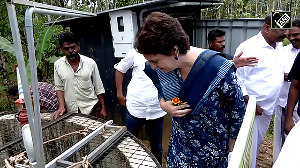India has been relentlessly moving on the path towards liberalization, opening up its markets and loosening its controls over many economic matters so as to integrate with the global economy.
Despite the opposition to globalization from some quarters, India has been quite watchful in its approach to embracing global economy. The issue of capital account convertibility is one such where the nation has tread very cautiously.
A high-level committee to look into this matter, appointed by the Reserve Bank of India, on Friday recommended that India move to fuller capital account convertibility over the next five years and has laid down the roadmap for the move.
So what is capital account convertibility?
To put is simply, capital account convertibility (CAC) -- or a floating exchange rate -- means the freedom to convert local financial assets into foreign financial assets and vice versa at market determined rates of exchange. This means that capital account convertibility allows anyone to freely move from local currency into foreign currency and back.
It refers to the removal of restraints on international flows on a country's capital account, enabling full currency convertibility and opening of the financial system.
A capital account refers to capital transfers and acquisition or disposal of non-produced, non-financial assets, and is one of the two standard components of a nation's balance of payments. The other being the current account, which refers to goods and services, income, and current transfers.
How are capital a/c convertibility and current a/c convertibility different?
Current account convertibility allows free inflows and outflows for all purposes other than for capital purposes such as investments and loans. In other words, it allows residents to make and receive trade-related payments -- receive dollars (or any other foreign currency) for export of goods and services and pay dollars for import of goods and services, make sundry remittances, access foreign currency for travel, studies abroad, medical treatment and gifts, etc.
Why capital account convertibility?
Capital account convertibility is considered to be one of the major features of a developed economy. It helps attract foreign investment. It offers foreign investors a lot of comfort as they can re-convert local currency into foreign currency anytime they want to and take their money away.
At the same time, capital account convertibility makes it easier for domestic companies to tap foreign markets. At the moment, India has current account convertibility. This means one can import and export goods or receive or make payments for services rendered. However, investments and borrowings are restricted.
But economists say that jumping into capital account convertibility game without considering the downside of the step could harm the economy. The East Asian economic crisis is cited as an example by those opposed to capital account convertibility.
Even the World Bank has said that embracing capital account convertibility without adequate preparation could be catastrophic. But India is now on firm ground given its strong financial sector reform and fiscal consolidation, and can now slowly but steadily move towards fuller capital account convertibility.
What is the Tarapore Committee?
The Reserve Bank of India has appointed a committee to set out the framework for fuller Capital Account Convertibility.
The Committee, chaired by former RBI governor S S Tarapore, was set up by the Reserve Bank of India in consultation with the Government of India to revisit the subject of fuller capital account convertibility in the context of the progress in economic reforms, the stability of the external and financial sectors, accelerated growth and global integration.
Economists Surjit S Bhalla, M G Bhide, R H Patil, A V Rajwade and Ajit Ranade were the members of the Committee.
The Reserve Bank of India has also constituted an internal task force to re-examine the extant regulations and make recommendations to remove the operational impediments in the path of liberalisation already in place. The task force will make its recommendations on an ongoing basis and the processes are expected to be completed by December 4, 2006. The Task Force has been set up following a recommendation of the Committee.
The Task Force will be convened by Salim Gangadharan, chief general manager, in-charge, foreign exchange department, Reserve Bank of India, and will have the following terms of reference:
- Undertake a review of the extant regulations that straddle current and capital accounts, especially items in one account that have implication for the other account, and iron out inconsistencies in such regulations.
- Examine existing repatriation/surrender requirements in the context of current account convertibility and management of capital account.
- Identify areas where streamlining and simplification of procedure is possible and remove the operational impediments, especially in respect of the ease with which transactions at the level of authorized entities are conducted, so as to make liberalisation more meaningful.
- Ensure that guidelines and regulations are consistent with regulatory intent.
- Review the delegation of powers on foreign exchange regulations between Central Office and Regional offices of the RBI and examine, selectively, the efficacy in the functioning of the delegation of powers by RBI to Authorised Dealers (banks).
- Consider any other matter of relevance to the above.
The Task Force is empowered to devise its work procedure, constitute working groups in various areas, co-opt permanent/special invitees and meet various trade associations, representative bodies or individuals to facilitate its work. It will make recommendations on an ongoing basis to rectify the anomalies and remove operational impediments. The processes are expected to be completed by December 4, 2006.
How does capital a/c convertibility affect you?
As most of us know, resident Indians cannot move their money abroad freely. That is, one has to operate within the limits specified by the Reserve Bank of India and obtain permission from RBI for anything concerning foreign currency.
For example, the annual limit for the amount you are allowed to carry on a private visit abroad is $10,000: of which only $5,000 can be in cash. For business travel, the yearly limit is $25,000. Similarly, you can gift or donate up to $5,000 in a year.
The RBI limit raises the limit if you are going abroad for employment, or are emigrating to another country, or are going for studies abroad: the limit in both these cases is $100,000.
You are also allowed to invest into foreign stock markets up to the extent of $25,000 in a year.
For the average Indian, these 'limits' seem generous and might not affect him at all. But for heavy spenders and those with visions of buying a house abroad or a Van Gogh painting, it will mean a lot. . .
But with the markets opening up further with the advent of capital account convertibility, one would be able to look forward to more and better goods and services.
And how will it affect Non-Resident Indians?
Capital account convertibility may NRIs as it will help remove all shackles on movement of their funds.
Currently, NRIs have to produce a whole lot of documents and certificates if they want to buy a house in India (for which the lock-in period is 10 years, meaning they can't take their money back overseas if they sell the house after having owned it for less than 10 years), or send money to India from their overseas accounts.
NRIs: Tax benefits may be removed
However, the Tarapore Committee on fuller capital account convertibility has recommended bringing foreign individuals on par with Non-Resident Indians in terms of convertibility and tax treatment.
The committee has proposed that the government must review tax benefits offered to NRIs for investments in foreign currency non-resident (banks) and non-resident (external) rupee account deposit schemes, while suggesting that foreign individuals be allowed to invest in these deposit schemes but without any tax concessions.
The committee said a movement towards capital account convertibility implied that all non-residents (corporates and individuals) should get equal treatment. This means that the tax benefits extended to NRIs under these schemes should be removed.
The committee recommends that these deposit schemes should be extended to non-residents (other than NRIs), in two phases.
In Phase I, non-residents could first be provided the FCNR (B) deposit facility, without tax benefits, subject to know-your-customer (customer identification) and financial action task force's (FATF) anti-money laundering norms.
Similarly, in Phase II, the NR(E)RA deposit scheme, with cheque writing facility, could also be extended to non-residents.
With respect to the capital market, at present only NRIs are allowed to invest in companies listed on the Indian stock exchanges, subject to certain stipulations.
The committee said all individual non-residents and non-resident corporates should be allowed to invest in the Indian stock market through Sebi-registered entities, including mutual funds and portfolio management schemes.
These entities will be responsible for meeting KYC and FATF norms and the money should come through bank accounts in India.
The committee has also recommended that the resident foreign currency (RFC) and RFC (deposit) accounts should be merged. The account holders should be allowed to move foreign currency balances to overseas banks.
For those wishing to continue with the RFC accounts, foreign currency current/savings chequable accounts should be provided, in addition to the foreign currency term deposits.





